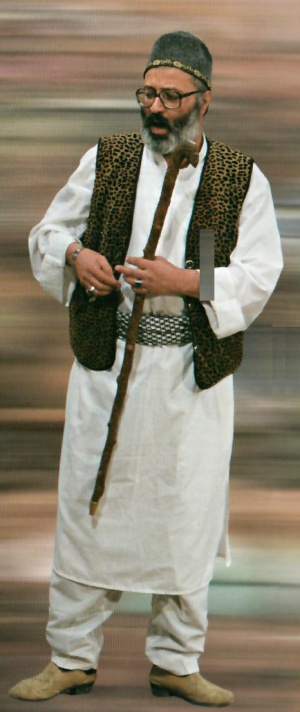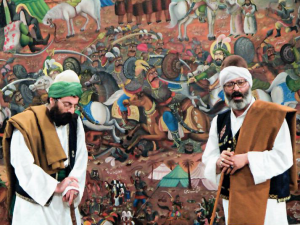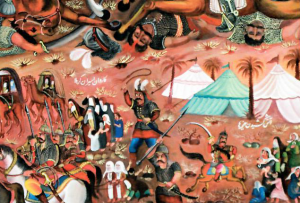Naghi sabbaq hamedani
Naqi Sabbaq Hamedani (born in 1952) is Pardekhan, Naqqal, Curtain Painter who started Pardekhani at the age of fifteen. The painted curtain used by Naghi Sabaq is closest to the modern style of painting called Coffeehouse Painting. Some similar elements such as perspective in the sequence of faces and places, composition of colors and type of coolers account for this closeness. In this curtain, the symbolic paintings, forms and spaces become earthly and the abstract look becomes de-emphasized.
Performance Method
In this type of curtain-storytelling, two curtain-masters narrate the curtain. Morshed Naghi Sabbaq along with Seyyed Hossein Havaeji perform in a particular fashion which is slightly different from the other kinds. In some sections, each of them take on the narration with the calm theatrical motions, and long songs all along with the same theme, and conversational narrations. This thoughtful calm follows through to the end of the narration of one gathering for a curtain. In the epic and battle scenes the motions suddenly pick up in speed in upheaval. In general, the performance includes walking along the length of the curtain, moving towards the audience, usage of the total space, indicating the painted faces, scenes of places and events while introducing the themes of the curtain. The most important distinguishing feature in this mode of performance is the continuity of one type of action or song and specific speech. Perhaps this kind of performance is more modern than the others, because it introduces a level of regularity in the constituting parts, and use of actions and speech and improvisation in song can be seen much less. The next point is the similarity of the costumes of the Morsheds which remind us of those residents of the Soffeh orders which in previous centuries lived in Hamedan as one of their centers, and is also the hometown of these Morsheds.
Narration
After the narration of side events, the story of the Convent of the Monk (Deir-e Raheb) is sung, the caravan of prisoners of the Battle of Karbala with Zeynab, Umm Kolsum, Fatima al-Soghra, Imam Sajad, and the cut heads of the 72 martyrs of Karbala on the spears, led by Shimr taken to Ibn Ziad to prove the victory of evildoers , and also Shimr receives a prize from the cruel ruler Saleh. On the way to Basra, there is a monk deep in worship who comes out disturbed by the uproar of the cries of women and children and the evildoers. He sees the heads on the spears with light flowing from them. However, among the shining, the light of one of the heads attracts his attention. He asks the evildoers about the fate of the caravan. Shimr introduces himself. The monk asks in exchange for a sack of gold to take the head into the convent for one hour. Shimr accepts. The monk washes the head with rosewater and puts it on the alter. Then he asks the head, "Oh Holy one, who are you?" The lips of the severed head spoke and said, “Imam Husayn, the son of Ali and my ancestor is Mohammad”.
Source
- Ardalan, hamidreza (2008). Picture-storyteller masters of Iran, the Iranian academy of the art, 2008, volume 22. ISBN: 978-964-2986-095(vol.22). 978-964-2986-002(set).



